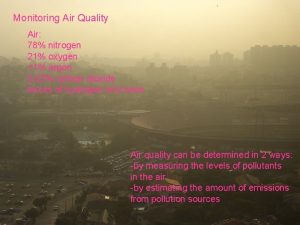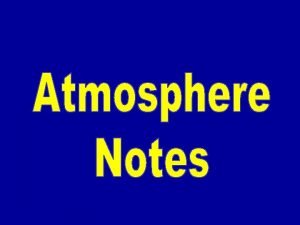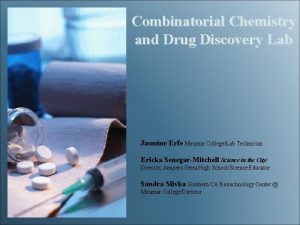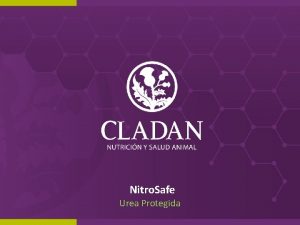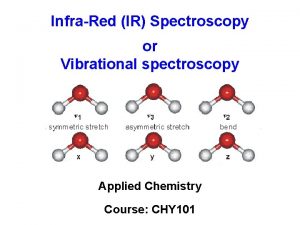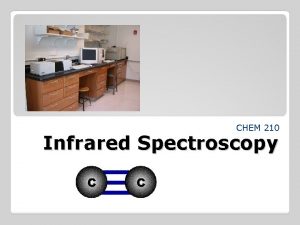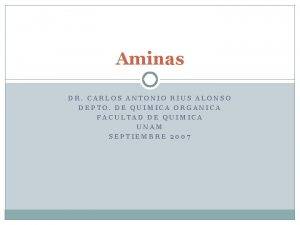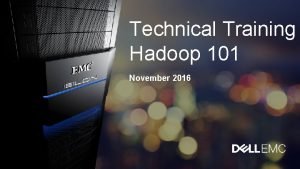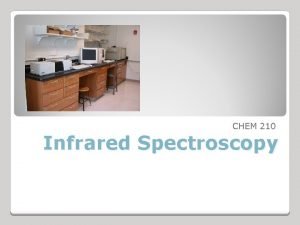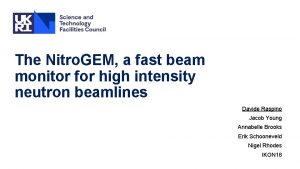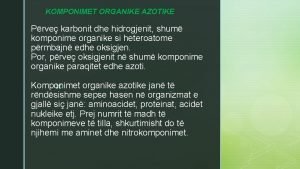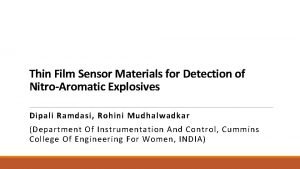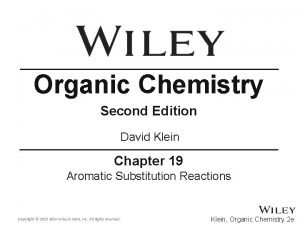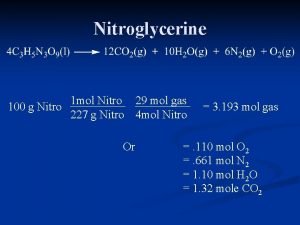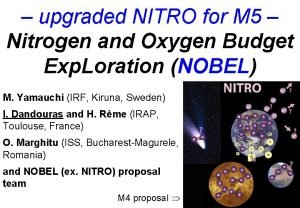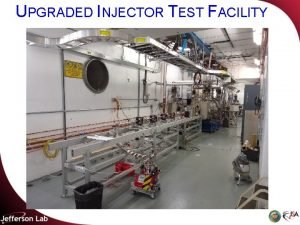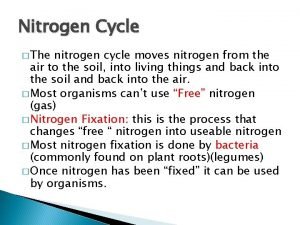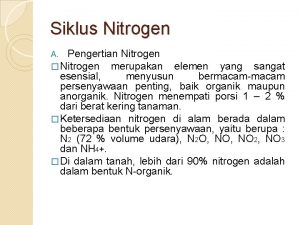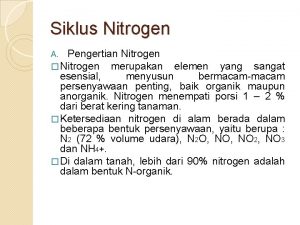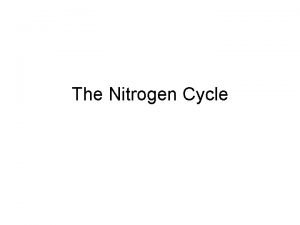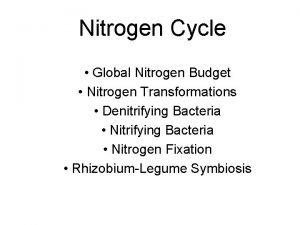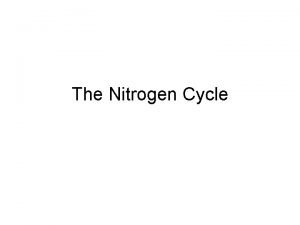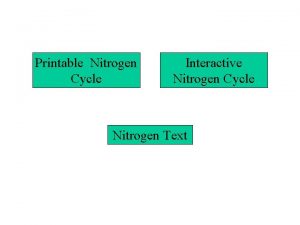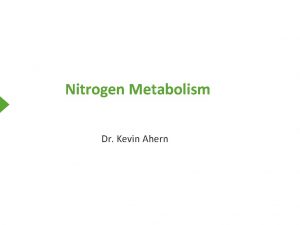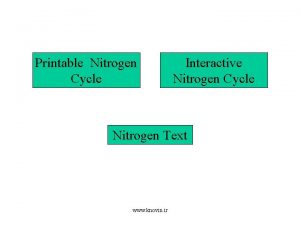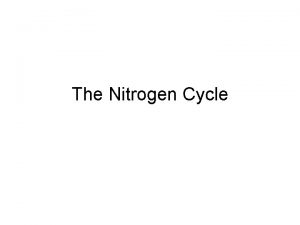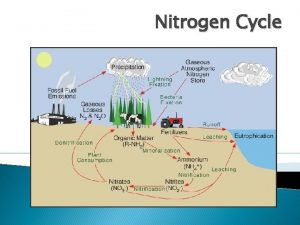upgraded NITRO for M 5 Nitrogen and Oxygen



















- Slides: 19

– upgraded NITRO for M 5 – Nitrogen and Oxygen Budget Exp. Loration (NOBEL) M. Yamauchi (IRF, Kiruna, Sweden) I. Dandouras and H. Rème (IRAP, Toulouse, France) O. Marghitu (ISS, Bucharest-Magurele, Romania) and NOBEL (ex. NITRO) proposal team M 4 proposal 1

Mission objectives 1. Earth diagnosis (exosphere/ escape) Study the amount of both thermal and non -thermal escape of major atmospheric components (nitrogen and oxygen) from the Earth. This requires first time exploration of the exosphere as well as first time examination of isotope ratios in the magnetosphere. 2. Atmospheric evolution The measurement quality must enable modelling of the escape on a geological time scale, and should be a good reference in understanding planetary evolution from their isotope ratio and N/O ratio. What is to be measured * Magnetospheric density distribution and fluxes for N+, N 2+, O+, and H+. * Energy distribution of each species in the magnetosphere. * Neutral and ion densities for N, N 2, O, O 2, at exosphere/ionosphere (> 1000 km). * Isotope ratio of neutrals and cold ions of oxygen (16 O, 17 O, 18 O) in both upper exosphere/ionosphere and magnetosphere 2 for a wide range of solar wind and solar EUV conditions

Why exosphere? Poor observational knowledge (No knowledge of > 800 km for nitrogen, > 1500 km for oxygen, and all altitude for isotope ratio) He < 800 km O < 700 km N 2 < 500 km O 2 Varies dynamically (Mars observation indicates unknown factors other than EUV) Mandatory for escape modeling (For thermal and some non-thermal escape) Source of cold ions above the ionosphere (They contribute feeding ions of non-thermal escape) one order of magnitude variation with 40% change in solar EUV-visible flux 3

Why nitrogen and isotope ratio? N 2+ N+ whereas O 2 O O+ (completely different solar/geomagnetic dependence) Scientifically important element (essential for amino-acid, and a representative volatile) Escaped amount could be significant for biosphere (Escape matters if ≥ 1026 ions/s) Not well known, but now possible to measure (impossible 5 years ago) Used as indicator of escape from planet (For better estimate, we need to know the difference in the isotope ratio between different escape processes) Poor observational knowledge (No knowledge in the magnetosphere/ionosphere) Mars atmosph Earth Mars interior Jupitor 4

Where is the optimum orbit? 1. Non-thermal escape can be estimated by covering both the exosphere and the inner magnetosphere. Orbital period ~ 10 hr resolution: 0. 1°/slit x 20 slits 2. The same orbit enables measurements of exosphere for both in-situ and remote sensing. With 20 sec spin, altitude resolution ~ 100 km 5

Payload Baseline Optional * Cold ion/neutral mass spectrometer N/O and 17 O/16 O separation (Bern) * IR emissions (TBD) N + , N 2, O + , * Ion mass analyzers (0. 03 – 30 ke. V): (1) m/q < 20 (Toulouse) (2) m/q > 10 (Kiruna) * Waves analyser (Prague) * Energetic Ion mass analyzer (UNH) * Magnetometer (Graz) * Search coil (TBD) * Auroral / airglow camera (Tohoku) * ENA monitoring (TBD) * Langmuir probe (Brussels? ) * Cold ion/neutral mass analyzer for fast sampling (Goddard) * Electron analyzer (London) * Potential Control (SC subsystem) * UV/visible emissions (Tokyo? ) N + , N 2, O + , 6

skip? Accommodation 7

Advantage of the Earth Sufficient dry mass (many heavier instruments) Sufficient telemetry (without large antenna that blocks FOV) Low altitude conjugate observations is possible (any low-altitude spacecraft such as NASA mission, and Ground-based observations such as EISCAT_3 D: conjugate > 20 passes/yr)

Advantage of the Earth skip? Covering area of EISCAT_3 D High sensitivity in more than 300 km diameter (white area) ≈ 10° longitudinal range. 3% of polar orbits traverses this region in average. With T~10 hours, NOBEL crosses once every 15 days in average. 9

Advantage of the Earth skip? Independent extra spacecraft possible 10

Design Spacecraft In-situ orbital period ~10 hr attitude control Spin (22 -26 sec) attitude reference Sun-pointing control method cold gas time resolution ≤ 2 min skip? angular resolution //, , and anti-// telemetry ~ 100 kbps life time 3 year 11

Extra science Planetary Evolution: meaning of isotope ratio and N/O ratio of a planet in terms of the escape history. Exoplanet modeling: tuning interpretation of optical data on exoplanets by having both spectral and in-situ measurements. Ionosphere Physics: ionization chemistry and transport at the topside ionosphere at different external conditions. Inner Magnetospheric Dynamics: using nitrogen as an independent tracer from oxygen. Space Plasma Physics (acceleration): different initial velocities between M/q=14 and M/q=16 give extra information. 12

Summary With recently developed reliable instrumentation, NOBEL will systematically study - the exospheric conditions, - nitrogen budget, - isotope ratio of cold ions/neutrals above 1000 km The knowledge is mandatory in understanding in estimating present-day’s thermal/non-thermal escape as well as behaviors of exosphere. The required instrumentation can also answer questions in the other areas.

END 14

If the nitrogen escape is large, #1 We can compare the two competing models more quantitatively: • N 2 delivery model (from comets, asteroids) + Volatiles are difficult to be included in proto-Earth (Temperature) + Volatiles should have escaped during the time of outgassing (EUV) – But amount of delivery is uncertain Expect neutral form with N 2 in primordial Earth • Protection of nitrogen from outgassing NH 3 + Naturally expected if the proto-Earth included nitrogen (as NH 3) + NH 3 rather than N 2 is expected because of higher Tcondensation – But difficult to protect from hydrodynamic massive escape Expect alkali form with NH 3 in primordial Earth 15

Nitrogen is missing on Mars Jeans escape does not explain it. Planetary formation does not explain it. Condensation temperature of TC(N 2) ~ TC(CO) << TC(CO 2) ~ TC(NH 3) indicates that condensation of N and C most likely occurred in the form of N 2–CO pair (~ 30°K) or NH 3–CO 2 pair (50 ~ 90°K). Therefore, N 2 content should be Mars > Earth > Venus. N 2 -Delivery model does not explain it. It should deliver on Mars too ? ? ? 16

If the nitrogen escape is large #2 Interpretation of isotope ratio 15 N/14 N will be questioned because total nitrogen escape is comparable between the Earth and Mars (a) Substantial Martian atmosphere could have been delivered by comet? (b) Simple difference in the escape mechanism? or (c) No outgassing happened, or all outgassed air has been lost at Early stage? ? 17

Atmosphere formation models Omit 18

earth history Omit 19
 78 nitrogen 21 oxygen and 1 other
78 nitrogen 21 oxygen and 1 other Nitrogen 78 oxygen 21
Nitrogen 78 oxygen 21 Kirby bauer
Kirby bauer Nitro functional group ir spectrum
Nitro functional group ir spectrum Nitro safe
Nitro safe Ir spectrum of ethyl acetate
Ir spectrum of ethyl acetate Ir peak for carboxylic acid
Ir peak for carboxylic acid Grupo nitro
Grupo nitro Hadoop 101
Hadoop 101 Spectroscopy equations
Spectroscopy equations Nitro gem
Nitro gem Nitro tavola periodica
Nitro tavola periodica Nitro amina
Nitro amina Nitro
Nitro Reduktim kuptimi
Reduktim kuptimi Nitro ntype
Nitro ntype Sulphonation mechanism
Sulphonation mechanism Nitro
Nitro Kontinuitetshantering
Kontinuitetshantering Typiska novell drag
Typiska novell drag
